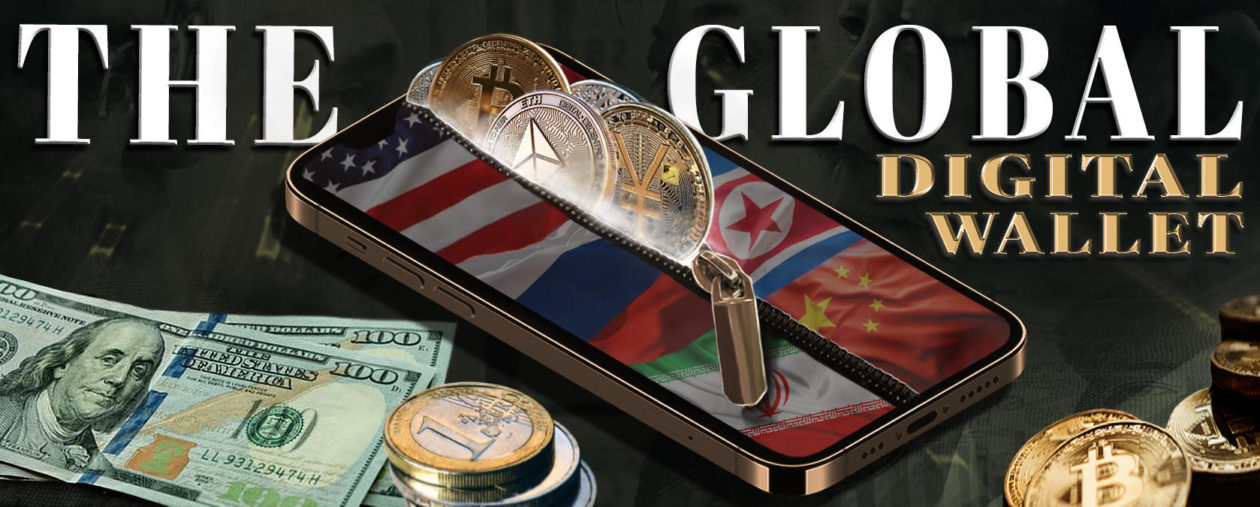It is 2026, and Canada, the United States and Mexico are co-hosting the World Cup. Nolan lands in Mexico City from Denver, excited to watch the upcoming soccer match at Estadio Azteca. Prior to taking off, she’d already filled her digital wallet with digital Mexican pesos (PesoCoin) to supplement her usual stash of her USD in the form of a central bank digital currency (FedCoin), Ether and Bitcoin. She commonly keeps FedCoin for general transactions and because it’s her native currency, Ether for “gas” when she has to use decentralized applications (dApps) on the Ethereum blockchain, and Bitcoin for general cryptocurrency liquidity.
Nolan calls a car on one of her rideshare apps to take her to her hotel. The rideshare app she uses recently switched to a decentralized blockchain after countless cyberattacks and the subsequent demands from users for more robust data protections. Ironically, Nolan’s digital wallet and the rideshare app use the same borderless cybersecurity technology to protect from hackers.

The multinational rideshare company that Nolan decides to use accepts payment in a variety of digital currencies and CBDCs — a concept that still raises hackles in many countries concerned about their financial sovereignty — so she can choose how she pays for her ride. However, local Mexican small businesses generally only accept PesoCoin, so Nolan came prepared. Of course, she could have waited until landing in Mexico to shift around her assets and make sure she had enough PesoCoin, but she prefers to take care of it in advance.
Nolan’s rideshare arrives at her hotel, and she decides to pay in PesoCoin. She thinks to herself: Our world becomes more connected every day, but why not act local when given the chance? Besides, her time in Mexico City will grant her plenty of opportunity to use the full capabilities of her digital wallet and the currencies within it.
Present-day digital transition
In the past year, we have seen a widespread push for credibility in the digital currency space from more decentralized tokens like Bitcoin and Ethereum, to central bank digital currencies (CBDCs) that are being explored by governments around the world. While it would be difficult for anyone to accurately predict which currencies will become most popular once the regulatory hurdles of digital currencies are overcome, one thing is for sure: digitalized money and financial systems are here to stay. Though people tend to think about conducting day-to-day transactions in a single currency, the financial landscape of the future is likely going to require ownership (and literacy) across several different types of money. Just as there is technology that is more useful for executing certain types of functions and performing tasks, these digital currencies of the modern world will each have their own unique benefits for a user. As a result, we can imagine a virtual wallet that will be commonplace among all consumers, requiring each person to select from a basket of currencies for each one of their transactions. This wallet could “live” in a variety of places and could take a variety of forms as we will see below, though the primary idea will stay the same: decentralized and centralized digital currencies alongside one another for use in a variety of exchange situations.
Different types of digital currency wallets
When we are so used to buying and selling things in a single denomination of money, it can seem overwhelming, overcomplicated, and unnecessary to have a virtual wallet that holds more than 10 balances from Bitcoin to Ethereum, from digital yuan to digital dollars. However, when thinking about the strengths and weaknesses of each currency in more depth, it becomes understandable why this will be the preferred method of holding monetary value. At the end of the day, modern capitalist consumers value choice, efficiency and optionality over anything else — and it is no different when it comes to methods of payment. Understanding the format of digital wallets and holding digital currencies is the first step to grasping the larger picture of an evolving financial landscape.
Virtual “hot” wallets are a purely digital method of holding assets connected to the internet. They are considered “hot” because the assets can be readily accessed, and value subsequently exchanged. This type of wallet is often directly connected to a personal bank account from which an individual can transfer funds. Hardware “cold wallets” are physical devices that hold digital asset accounts offline. They are considered “cold” because they must be connected to the internet in order to become “hot” or for value to be exchanged. By taking a wallet offline, users can further protect their digital assets from malicious actors that could compromise a system or platform through Internet-enabled services.
What will your wallet hold?
In the next few years, we are going to see a rapid shift to the use of digital currencies for a variety of uses from business-to-business (B2B), simple consumer transactions, and banking. Since different currencies are preferred for certain types of transactions, it should be expected that individuals will have their own unique sets of digital currencies for their primary methods of exchange. Your virtual wallet will have whichever currencies you primarily transact in, with the ability to exchange, add, or subtract value depending on your evolving demands.
Virtual wallet NFT
Virtual wallets will have a graphic user interface that displays all the different currencies side-by-side, with each of their individual values. The non-fungible token that is being auctioned with this piece is an artistic vision of what will be possible in the future use of digital currencies. This user interface displays many different currencies that an owner would be faced with upon opening their virtual wallet application or software. The first of its kind, this NFT highlights a new type of digital wallet that will be popularized and necessary for the modern consumer or business owner.
Digital finance will continue to change the world in ways impossible to predict. The evolution of the digital wallet will be a crucial aspect of this “brave new world.” It is important for us to ask ourselves some broad questions: Are we presumptuously projecting the future of digital finance onto our existing financial world instead of re-imagining a completely new architecture?
When Nikolaus Otto invented the internal combustion engine in the mid-19th century, did he appreciate the revolutionary impact it would have? Could he imagine the vast American Interstate Highway System constructed nearly one century later to accommodate the automobiles that his invention had begotten? If digital currencies and wallets are revolutionary technologies akin to the combustion engine, are we imaginative enough to foresee the digital equivalent of the interstate highway system and the radical change it will bring? What if liquidity in digital currency markets is so great that individuals never have to “carry” more than one digital currency in their mobile wallet?
If the digital world advances to where financial settlement is near-instant, will anyone choose to carry multiple currencies instead of picking the one with the most utility and liquidity for him and then swapping as needed? How will this impact global foreign exchange markets, and the weaker currencies traded on these markets?
U.S. innovation and next steps
As 2026 approaches and this concept becomes more tangible, the United States must innovate rapidly while representing American values of privacy, financial inclusions, ethics and morality. At the same time, it must compete with other currencies and countries that strive for positions at the top of the global financial totem pole. A world in which there is a “basket of currencies” is almost upon us, and with it comes the optionality and choice that citizens of the world value most of all.
While it is inevitable that the U.S. dollar continues to be high on the list of currencies of choice for members of the global economy, it must innovate to remain the preferred currency into the future. This will require a steadfast commitment to American values and rapid innovation as technology improves.





